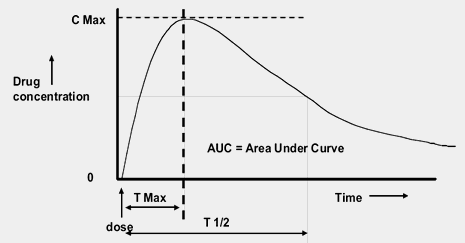What happens when you take a drug?
If you understand what happens when you take a drug through the following graphs, you will understand the science behind adherence.
What happens to drugs in the body?
When you take a drug, it is absorbed into the blood and distributed round the body. The drug reaches a peak level. Soon after this, the drug level falls steadily as its is eliminated from the body.
How a drug is absorbed by your body into the blood depends on the way it is taken:
- A pill is usually absorbed into the blood through the stomach walls after it is swallowed – these can become active in a few minutes but usually take an hour or two to reach the highest concentration in the blood.
- IV drugs are injected directly into the blood work much faster – sometimes in seconds or minutes.
However a drug is taken, it will reach a peak level and then these levels will go down as the body breaks down the active ingredients, usually as the circulating blood is filtered by the liver or kidneys.
This basic process happens with every drug – alcohol, nicotine, aspirin, HIV drugs…
Drugs are always absorbed more quickly than the body can break them down, so the highest concentration is reached relatively quickly, and then it takes longer to leave the body.
Drug absorption

- After taking a drug, levels peak quickly then drop slowly as the drug is eliminated (cleared from the body) – every drug has its own absorption curve.
- The highest concentration is called the Cmax.
- The total exposure to drug over the dosing period is call the Area Under the Curve (AUC)
- The time taken to get to the highest concentration is called the Tmax
- The time taken to reduce the highest concentration by half (by 50%) is called a drug’s ‘half-life’ or T½.
- It takes approximately 5 half-lives for a drug to be cleared to negligible levels, but in theory, tiny quantities can be in the body for much longer.
- When a drug is taken routinely as treatment, the lowest concentration just before the next dose is called the Cmin or Ctrough (trough level).
Drug absorption after multiple doses

- Each dose taken on time makes sure that the drug stays above the lowest useful level (called the Minimum Effective Concentration or MEC).
- Remember that all these results are averages.
- Some people absorb drugs more quickly or more slowly than the average.
- Some people clear drugs more quickly or more slowly than the average.
- These results are usually only calculated in blood and blood levels do not always relate to how active a drug is inside a cell. With nucleoside analogues, the level of the active drug inside the cell is more important than blood levels – graphs for drugs levels inside cells would follow a similar pattern, but are more difficult to measure With some nucleosides, the levels in blood or plasma do not match the levels inside cells.
Pharmacokinetics
Pharmacokinetics is the name for ways that drugs are absorbed and eliminated by the body.
Although drugs behave differently in different parts of the body (blood, brain, genital fluids, inside different cells etc) the basic principles of absorption and elimination are similar.
Studies looking at drug levels in genital fluids use the same terms and measurement as drug levels in blood (Cmin, Cmax etc). Importantly, a drug behaves differently in each compartment.
Some drugs are rapidly absorbed in blood but might take a day to reach maximum levels in genital fluids. Some drugs have much higher concentrations in genital fluids than they in blood.
Last updated: 22 July 2009.
